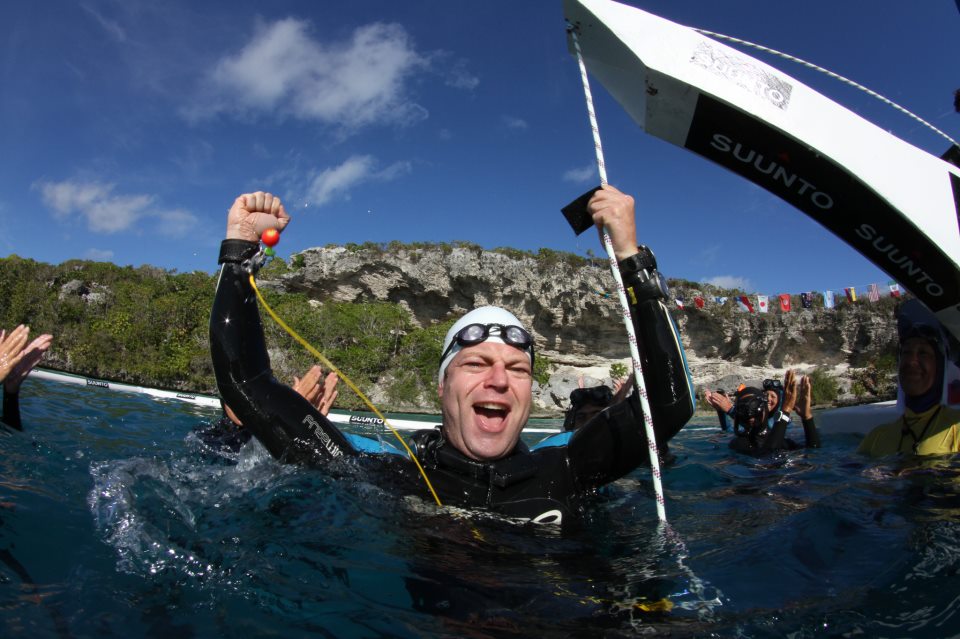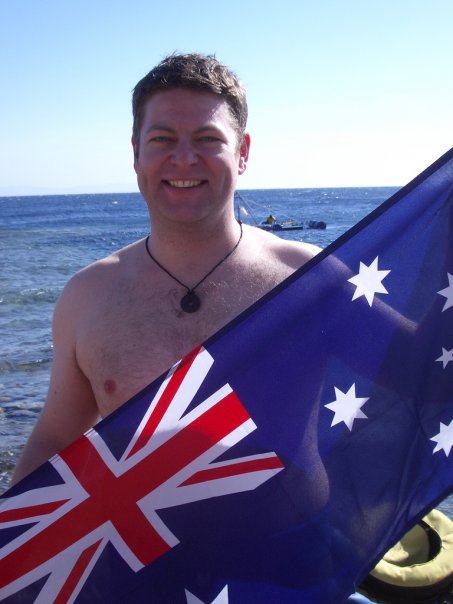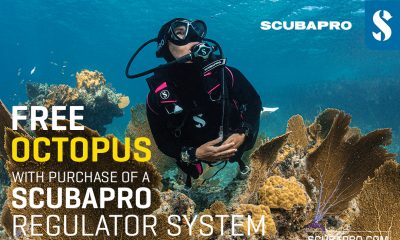News
Freediving Focus: Ben Noble

Australian Freediving champion Ben Noble talks about his latest Australian Record dives.
In June2010 I travelled to Greece to attend the 3rd Mediterranean Freediving World Cup 2010, held in the Messinian Bay near the coastal township of Kalamata. The World Cup, in its third year attracts some of the best freedivers from around the globe. The contest was held over 5 days of diving and included the three depth disciplines of Constant Weight (the freediver descends to depth and back using fins or a monofin), Constant Weight Without Fins (diving without the use of fins) and Free Immersion (diving without using fins but allowing the diver to pull on the rope), the winner having the highest score from their best dives in each discipline. In addition, the organisers had set up a freediving sled, a device used in the two other depth events of Variable Weight (using a sled to descend, then leaving it and swimming back up) and No Limits (using a sled to descend then activating a lift bag to bring the diver back up). These events are not offered in competition due to the logistical difficulties as well as the dangers of the deeper dives that they allow.
In Egypt two years earlier I had set Australian records in Variable Weight and No Limits at 72m and 80m respectively, and when I discovered that there would be sled facilities at the competition site I decided to see if I could extend these records a little more, with the vague notion of a 3 digit figure in the back of my head. With this in mind I started my training regime straight after New Year’s celebrations. I broke my training down into three main elements – general fitness training, breath hold training and depth training.
Since returning to Australia in 2008 my fitness had taken a back seat whilst I returned to the regime of getting a job and settling back into the Australian way of life of barbecues, beers and catching up with old mates. Before I knew it I had put on a significant amount of weight and had become somewhat of a couch potato. I sat down with my personal trainer, outlined my goals and put myself on a strict high protein, low carbohydrate, no alcohol eating plan. As my fitness returned I ramped up the intensity, and at my peak I was training at the gym around 10 times a week – sneaking off at lunch for a quick cardio session then another weight session in the evening and walking 5km home each night. By the time of the competition I had lost 20kg and had pretty good tolerance for lactic acid burn, essential for deep diving when you get excruciating lactic acid build-up in your legs.
During this time I was also training my ability to hold my breath, and also my ability to tolerate high levels of Carbon Dioxide, which trigger the body’s urge to breathe when holding your breath. One of the more bizarre exercises I included in a gym session (don’t try this at home!) was a 40 second breath hold on the seated bike whilst pedalling followed by a 20 second recovery and then repeated for an hour. I also included a pool session once a week doing various breath holds.
For my depth training it was a little hard to find good access to deep water where I live in Brisbane so once or twice a month I would fly to Cairns and dive in an old volcanic crater that was rumoured to be around 80m deep. Ideally I would have liked a lot more depth training but I knew that I had 7 days to train before the competition, and generally my depth training is more effective in the days leading up to a deep dive.
When I finally arrived in Greece my first day of diving was quite unsettled – new equipment, new safety team and my first deep dive in salt water in three years. After a couple of shallow warm up dives we set the rope to 70m – the purpose of this dive was not the depth but really to get used to the setup and to make sure everything felt fine both physically and mentally. The training dives were all Variable Weight dives, as training Variable also trains No Limits, killing two birds with one stone. My first mistake was to not wear a belt around my waist; as soon as I left the surface my wetsuit filled up with water and ballooned the whole way down. I also had equalisation problems past around 50m and had to use the brake on the sled a couple of times to stop before the pressure built up too much in my ears. The swim back to the surface felt great however so I knew my hours in the gym had paid off.
During the next 6 days my diaphragm became more flexible with each dive and I went from 70m to 80m, 83m and 90m. On the following day I looked at my dive gauge after what felt like a good dive only to see to my dismay that the gauge had malfunctioned and just had dashes across the screen. I grumbled something under my breath and a safety diver came over, looked at my gauge, smiled and said “you know these gauges don’t work past 100m. Well done!” I had made my target of 100m. Later that afternoon I announced an Australian Record attempt of a Variable Weight dive to 100m for the following day.
Perfect conditions greeted us in the bay the next morning and I got in the water for my usual warm ups. After these were completed I made my way over to the official rope and started my last 5 minutes of preparation. When I was ready, I took my last breath and released the brake on the sled. With 20kg of ballast, the sled moved quite fast and within a few seconds I felt the water temperature drop which is a signal that i’m around 30m already. Around this point I changed equalising methods to “mouthfill” – a technique moving air from the lungs to the mouth in order to be able to continue equalising a lot deeper. This works for some time but gradually it gets harder and harder to equalise, until I hear the beeping of my depth alarm telling me i’m nearly at the bottom. There was a noise as the sled hit the end of the rope and my descent suddenly stopped and the realisation that I was at 100m began to hit me. Exactly 1 minute has passed as I started my ascent, kicking hard off the bottom using my monofin, a Russian-made fin that looks a bit like a dolphin tail. The swim to the surface was long, a minute and a half in total and my legs started to fatigue about three quarters of the way up. Eventually I saw a safety diver meeting me at 30m which gave me a little mental push and the last few metres I stopped kicking completely and let my buoyancy carry me to the surface. On the surface I took 3 huge breaths of air and performed my surface protocol to the watching judges – taking my goggles and noseclip off, giving an OK sign and saying “I am ok” within 15 seconds of surfacing. There was a nervous wait as the judges determined that I was not about to black-out and I have not violated any rules, until finally they smiled and concluded the dive was successful. I was elated about the record, but I think I was even more elated about the fact that I could finally have a day off from diving the next day.
After my day off the competition started and I had two successful Constant Weight dives. The next day was supposed to be a rest day but I was feeling quite healthy so I decided to make an attempt on the No Limits Australian record. For No Limits, the sled is altered slightly in that a lift bag is attached and a tank added to inflate the bag. With my warm ups done, I went to the main rope and had a crash course in sled operation, did my breath up and released the brake. The first thing I noticed was that without my monofin (I was wearing standard fins) there was less drag and I was going a lot faster through the water. The trip down was good and my equalising felt a lot better than my previous dive, although the increasing pressure made it more difficult to equalise near the bottom – at 105m there is over 11 times the pressure which makes my 7 litre lungs compress to just over half a litre. As I hit the bottom I started to fill the lift bag which seemed to take forever to fill – what felt like a minute was actually around 20 seconds and I started to realise that I was suffering from Nitrogen Narcosis – the “rapture of the deep” that can make a diver feel euphoric and more than a little spaced out. Eventually the sled started to move and started my journey back to the surface. I was surprised at how fast the sled was travelling; at one point I looked up and my goggles were torn from my face and my wetsuit hood started to peel back. Somewhere around 50m I let go of the sled, I wanted to slow down at the end and enjoy the last part of the dive. Gradually I could see the surface approaching with the outline of the boat and a myriad of safety divers, in water judges, cameramen and some casual observers. As I approached, everyone cleared out of the way and I surfaced for my first breath of air in nearly 3 minutes. The judges judged, I waited and a minute later I had my Australian record dive of 105m and became the first Australian to have dived past 100m on a single breath of air.
With the pressure of the records now behind me, I enjoyed my 3 last dives of the competition in Free Immersion and Constant Weight No Fins and managed personal best depths in each dive. I placed 8th in the competition and since then have not had a day go by without daydreaming of diving in the amazing waters of the Mediterranean.
Now back in Australia, I am an accredited AIDA Freediving Instructor and I teach AIDA courses in and around Queensland in some of the most beautiful waters in the world. If you would like to do a freedive course please contact info@freedivedownunder.com
News
Dive Worldwide Announces Bite-Back as its Charity of the Year

Over the next 12 months, specialist scuba holiday company Dive Worldwide will be supporting Bite-Back Shark & Marine Conservation with donations collected from client bookings to any one of its stunning dive destinations around the world. The independently-owned operator expects to raise £3000 for the UK charity.
Manager at Dive Worldwide, Phil North, said: “We’re especially excited to work with Bite-Back and support its intelligent, creative and results-driven campaigns to end the UK trade in shark products and prompt a change in attitudes to the ocean’s most maligned inhabitant.”
Bite-Back is running campaigns to hold the media to account on the way it reports shark news along with a brand new nationwide education programme. Last year the charity was credited for spearheading a UK ban on the import and export of shark fins.
Campaign director at Bite-Back, Graham Buckingham, said: “We’re enormously grateful to Dive Worldwide for choosing to support Bite-Back. The company’s commitment to conservation helps set it apart from other tour operators and we’re certain its clients admire and respect that policy. For us, the affiliation is huge and helps us look to the future with confidence we can deliver against key conservation programmes.”
To launch the fundraising initiative, Phil North presented Graham Buckingham with a cheque for £1,000.
Visit Dive Worldwide to discover its diverse range of international scuba adventures and visit Bite-Back to learn more about the charity’s campaigns.
MORE INFORMATION
Call Graham Buckingham on 07810 454 266 or email graham@bite-back.com
Gear News
Scubapro Free Octopus Promotion 2024

Free Octopus with every purchase of a SCUBAPRO regulator system
Just in time for the spring season, divers can save money with the FREE OCTOPUS SPRING PROMOTION! Until July 31st SCUBAPRO offers an Octopus for free
with every purchase of a regulator system!
Get a free S270 OCTOPUS with purchase of these combinations:
MK25 EVO or MK19 EVO with A700
MK25 EVO or MK19 EVO with S620Ti
MK25 EVO or MK19 EVO with D420
MK25 EVO Din mit S620Ti-X
Get a free R105 OCTOPUS with purchase of the following combinations:
MK25 EVO or MK19 EVO with G260
MK25 EVO or MK17 EVO with S600
SCUBAPRO offers a 30-year first owner warranty on all regulators, with a revision period of two years or 100 dives. All SCUBAPRO regulators are of course certified according to the new European test standard EN250-2014.
Available at participating SCUBAPRO dealers. Promotion may not be available in all regions. Find an authorized SCUBAPRO Dealer at scubapro.com.
More information available on www.scubapro.com.
-

 News3 months ago
News3 months agoHone your underwater photography skills with Alphamarine Photography at Red Sea Diving Safari in March
-

 News3 months ago
News3 months agoCapturing Critters in Lembeh Underwater Photography Workshop 2024: Event Roundup
-

 Marine Life & Conservation Blogs3 months ago
Marine Life & Conservation Blogs3 months agoCreature Feature: Swell Sharks
-

 Blogs2 months ago
Blogs2 months agoMurex Resorts: Passport to Paradise!
-

 Blogs2 months ago
Blogs2 months agoDiver Discovering Whale Skeletons Beneath Ice Judged World’s Best Underwater Photograph
-

 Gear Reviews2 weeks ago
Gear Reviews2 weeks agoGEAR REVIEW – Revolutionising Diving Comfort: The Sharkskin T2 Chillproof Suit
-

 Marine Life & Conservation2 months ago
Marine Life & Conservation2 months agoSave the Manatee Club launches brand new webcams at Silver Springs State Park, Florida
-

 Gear Reviews3 months ago
Gear Reviews3 months agoGear Review: Oceanic+ Dive Housing for iPhone

















